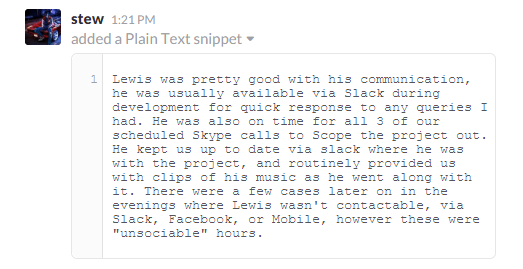Below is the final Timeline X gameplay introduction trailer
Author Archives: Lewis Whitworth
Overall Reflective Summary
The final Timeline X gameplay introduction trailer differs from the initially proposed trailer in the project proposal in a number of ways. Firstly the final trailer only has music in the soundtrack in contrast to the initially proposed music, sound effects and dialogue. Secondly the final trailer doesn’t have the initially proposed VHS filter video effect. Lastly the final trailer is 1:17 minutes long at 24 frames per second as opposed to the initially proposed 1:30 minutes at 60 frames per second.
These project changes from the originally proposed to final Timeline X trailer happened due to time constraints and changes in creative decisions . As Dan Shepard pointed out plans often go off schedule so you have to adapt. In terms of project changes I removed dialogue and focused on creating text graphics for the trailer because Stewart Whitworth decided that he didn’t want a narrator and felt that text graphics would create a more ideal serious tone for the trailer. Furthermore I removed sound effects from the final trailer due to time constraints where my, Stewart’s, Paul’s and Daniel’s workloads were full and we didn’t have time to produce sound effects.
Below is each learning outcome I set myself from the project proposal with an explanation of how I met each learning outcome.
- ‘Build new areas of creativity like producing music that’s tailored to the action on screen, Creating sound effects with an retro 80s arcade feel and producing a storyboard.’ – My strengths on this learning outcome are researching Anahid Kassabian’s notion of the ‘attention continuum’ and term ‘Commentary music’ which underpinned my approach to producing music tailored to the action on screen. I adopted the ‘attention continuum’ by creating an equal level of audience attention between the music and visual elements and utilized the term ‘Commentary music’ by timing musical components to be synchronized with shot cuts and supporting the atmosphere within the shot. Furthermore I produced a storyboard to give me a clear vision of what visual elements I was tailoring music to. My weaknesses on this learning outcome are not creating sound sound effects and setting myself more areas of creativity than I could manage so to improve I would set myself a reasonable number of areas of creativity.
- ‘Electronic music production and mixing skills’ – My strengths on this learning outcome are researching a range of practical mixing and production approaches and techniques From Mike Senior’s ‘Mixing Secrets for the Small Studio’ and from Nigel Silva’s YouTube tutorial on making 80s influenced music in FL Studio which underpinned my approach to producing and mixing the Timeline X trailer music. I have improved production skills such as navigating the FL studio interface more efficiently, knowing which order of instruments to work on and composing 80s style music. I have improved mixing skills such as level balancing instruments in order of importance whilst keeping the quieter instruments fairly prominent in the mix and Equalization through a reductive approach where i’m making space for the frequencies of other instruments. I started the project with long production sessions lasting several hours but as I progressed through production I learnt through trial and error to shorten production session times with breaks in between. Shorter production sessions and in turn mixing sessions gave my ears and perception of the trailer music a rest so I could come back to each session with a clearer perception of the tracks. My weaknesses on this learning outcome are not researching a larger number of practical mixing and production approaches and techniques so to improve I would do so to help me gain a wider perspective on practical mixing and production approaches and techniques.
- ‘Video editing and video effects production skills’ – My strengths on this learning outcome are improvements in video editing skills such as navigating the adobe premiere interface more efficiently and cutting clips to match music. Furthermore I have improved video effects production skills like navigating the adobe after effects interface more efficiently and matching effects like the flash to a musical component such as a lead synth chord. My weakness on this learning outcome are not doing any research on video editing and video effects from experts and Relying on YouTube tutorials so to improve I would research from experts on Video editing and video effects to give me a some more effective approaches and techniques.
- ‘Developing my communication skills’ – My strengths on this learning outcome are communicating with Stewart, Paul and Daniel in a clear and concise way on the team collaboration software Slack. To elaborate I often kept up to date and discussed the development of the game with the team and informed the team about my progress with the storyboard and music. If I was ever unsure about one of the teams comments I would ask for clarification to understand their point. Below is a screenshot of Stewart Whitworth’s feedback on my communication skills.
My weaknesses were not using a more direct form of communication with the team and not being contactable. To improve I would have used a more direct form of communication software like Skype more often. I had a few skype calls with Stewart however the team never had a group skype call which may have allowed the team to more openly express thoughts and ideas. Furthermore I would have stayed in contact in the evenings via Slack, Facebook and mobile.
- ‘Developing organisation’ – My strength on this learning outcome is adapting to the timescale/plans which went off schedule. Due to time constraints and changes in creative decisions I had to make decisions such as cutting dialogue and sound effects from the Timeline X trailer. I set myself and the team realistic time frames to complete different components of the Timeline X trailer and as a result stopped following the original timescale/plan in the project proposal. My weaknesses on this learning outcome are overestimating the workload of the team and not having back up plans in case the original plans go off schedule. To improve I would consult my team more in depth about their workload and what they can realistically manage to create a timescale that suits the team and create a back up plan/schedule that won’t heavily affect the final product.
Timeline X In-game music influences
The Timeline X in-game music is by influenced by a range of artists/genres. Like the trailer music the in game music is a combination of primarily synthwave with elements of Baroque. I will analyse the in-game music influences the same way as the Timeline X trailer music influences by doing semiotic analysis based on Ferdinand de Saussure’s model of the sign.
Scattle is a synthwave artist who has released a number of EPs and albums. The signified or connotations of ‘Inner Animal’ are dread, the 80s and slick. As with ‘Interceptor’ by Mitch Murder the 80s connotation which stands out the most is brought out by all of the the musical elements including synths, drums and bass which were common conventions found in popular 80s music The slick connotion is brought out by the quick sweep effect that pans from left to right. I used these musical elements to make the two brothers seem more tough and to provide a sense of progression within the level.
Andreas Waldetoft is a composer known for his work on video game soundtracks such as the ‘Europa Universalis’ and ‘Hearts of Iron’ series. The signified or connotations of ‘King’s Court’ are royalty, the renaissance and baroque music. I utilized the harpsichord to reflect these connotations and to give the player a sense of being in 1600s england. The harpsichord isn’t at the forefront of the in-game tracks because I wanted the 80s vibe to be the primary theme.
Removal of Sound Effects
I have chosen to remove sound effects from the Timeline X trailer due to time constraints. Work associates Daniel Scott and Paul Barrass have not had the time to produce sound effects and detailed intro/outro graphics. Daniel and Paul have put all of their time towards providing artwork for Stewart. I’ve been putting all of my time into producing the music for the trailer and draft levels, managing video clips and producing text graphic effects whilst Stewart has been creating parts of the game based on the storyboard.
Essentially all of our workload has been full and we haven’t had time for the sound effects so the soundtrack for the trailer will be music only. With regards to Anahid Kassabian’s notion of the ‘attention continuum’ the removal of sound effects will make the music more prominent in the ‘attention continuum’. I still have the same aim of creating an equal amount of attention to the music and visual elements. The way the soundtrack works in the Timeline X trailer will be similar to the Power Drive 2000 trailer where the the music and visuals work symbiotically to create intensity and reveal the neo 80s atmosphere to the audience.
Producing the Timeline X In-game Music
The following 2 tracks are draft tracks of in-game music on different levels/maps. Underneath each track is a concept art image of what the level is likely to look like.
The first track plays in the open field/giant graveyard map during night time. The environment of this map has emphasis on horror themes made prominent by the nightime setting and graveyard/church that carries undead supernatural connotations. The fast paced bass synths and slow ghost themed synths reflect the undead supernatural connotation whilst the minor chord patterns of the harpsichord reflect the bleak nightime setting.
The second track plays in a town map during daytime. The environment of this map is based around the town becoming a battleground with bodies on the streets, enemies within close range and buildings smashed and on fire. Furthermore the town map has connotations of danger, progression and triumph because the player has to go through challenging close quarter fights to control the town territory. The slow bass synths reflects the connotation of constant danger whilst the chord and melody progression of the harpsichord and lead synths reflect the connotations of progression and triumph.



